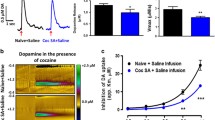Abstract
The i.v. pentylenetetrazol seizure threshold was increased by 2.5 mg/kg and decreased by 15 mg/kg of a single (+)-amphetamine dose. After 7 consecutive days of amphetamine administration, tolerance developed to the decrease but not to the increase in seizure threshold. At 12–48 h after the last dose of 2.5 mg/kg seizure threshold was decreased, and at 36–48 h after the last dose of 15 mg/kg seizure threshold was increased. After acute and chronic administration of (+)-amphetamine (2.5 mg/kg) endogenous concentrations of whole brain dopamine (DA) were increased and returned to normal levels during the withdrawal period (12–48 h); endogenous norepinephrine (NE) levels were unchanged by acute and chronic drug treatment and during withdrawal. The rates of DA and NE synthesis were increased by chronic amphetamine administration at 24–48 h after drug withdrawal. An acute dose of (+)-amphetamine (15 mg/kg) decreased endogenous levels of DA and NE; normal levels of DA were detected with chronic drug treatment and during withdrawal, with NE remaining slightly depressed. The rates of synthesis of DA and NE were increased by acute and chronic amphetamine treatment and returned to normal 24–48 h after withdrawal. The rebound reversal in seizure threshold after (+)-amphetamine withdrawal suggests an abstinence syndrome that may be interpreted as evidence for the development of physical dependence to (+)-amphetamine after chronic drug administration.
Similar content being viewed by others
References
Campbell, J. C., Seiden, L. S.: Performance influence on the development of tolerance to amphetamine. Pharmacol. Biochem. Behav. 1, 703–708 (1973)
Gerald, M. C., Riffee, W. H.: Acute and chronic effects of d- and l-amphetamine on seizure susceptibility in mice. Europ. J. Pharmacol. 21, 323–330 (1973)
Goldstein, A.: Biostatistics: An introductory text, pp. 184–187. New York: MacMillan 1964
Hug, C. C.: Characteristics and theories related to acute and chronic tolerance development. In: Chemical and biological aspects of drug-dependence, S. J. Mulé and H. Brill, eds., pp. 307–358. Cleveland: CRC Press 1972
Jaffe, J. H.: Drug addiction and drug abuse. In: The pharmacological basis of therapeutics, 5th ed., L. S. Goodman and A. Gilman, eds., pp. 284–324. New York: MacMillan 1975
Kalant, H., LeBlanc, A. E., Gibbins, R. J.: Tolerance to, and dependence on some non-opiate psychoactive drugs. Pharmacol. Rev. 23, 135–191 (1971)
Kosman, M. E., Unna, K. R.: Effects of chronic administration of the amphetamines and other stimulants on behavior. Clin. Pharmacol. Ther. 9, 240–254 (1968)
Lewander, T., Jonsson, J.: Isolation and determination of free endogenous and radioactive tyrosine in studies on catecholamine synthesis in the rat brain. Life Sci. 7, 387–394 (1968)
Lewander, T., Moliis, G., Brus, I.: On amphetamine tolerance and abstinence in rats. In: Frontiers in catecholamine research, E. Usdin and S. H. Snyder, eds., pp. 987–989. Oxford: Pergamon Press 1973
Magour, S., Coper, H., Fahndrich, Ch.: The effects of chronic treatment with d-amphetamine on food intake, body weight, locomotor activity and subcellular distribution of the drug in rat brain. Psychopharmacologia (Berl.) 34, 45–54 (1974)
Orloff, M. J., Williams, H. L., Pfeiffer, C. C.: Timed intravenous infusion of metrazol and strychnine for testing anticonvulsant drugs. Proc. Soc. exp. Biol. (N. Y.) 70, 254–257 (1949)
Oswald, I., Thacore, V. R.: Amphetamine and phenmetrazine addiction: physiological abnormalities in the abstinence syndrome. Brit. med. J. 2, 427–431 (1963)
Riffee, W. H., Gerald, M. C.: Determination of endogenous concentrations of norepinephrine and dopamine and their rates of synthesis in a single mouse brain: Biphasic effects of (+)-amphetamine. Arch. int. Pharmacodyn. 219, 70–78 (1976a)
Riffee, W. H., Gerald, M. C.: Effects of amphetamine isomers and CNS catecholaminergic blockers on seizures in mice. Neuropharmacology 15, 677–682 (1976b)
Seevers, M. H., Deneau, G. A.: Physiological aspects of tolerance and physical dependence. In: Physiological pharmacology, Vol. I, Part A, W. S. Root and F. G. Hofmann, eds., pp. 565–677 New York: Academic Press 1963
Tormey, J., Lasagna, L.: Relation of thyroid function to acute and chronic effects of amphetamine in the rat. J. Pharmacol. exp. Ther. 128, 201–209 (1960)
Author information
Authors and Affiliations
Rights and permissions
About this article
Cite this article
Riffee, W.H., Gerald, M.C. The effects of chronic administration and withdrawal of (+)-amphetamine on seizure threshold and endogenous catecholamine concentrations and their rates of biosynthesis in mice. Psychopharmacology 51, 175–179 (1977). https://doi.org/10.1007/BF00431736
Received:
Issue Date:
DOI: https://doi.org/10.1007/BF00431736




